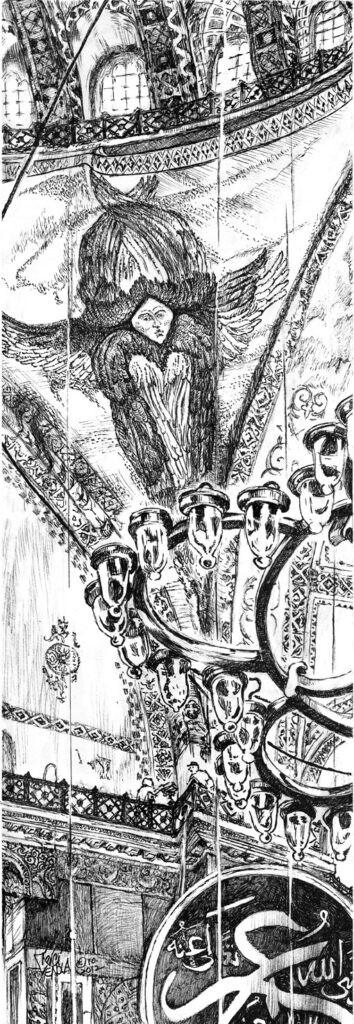
NOTE: Since the conversion of Hagia Sophia into a mosque, several of the artworks described here are no longer visible, but they’re still there. Behind the curtains and under the carpets, laughing at us.
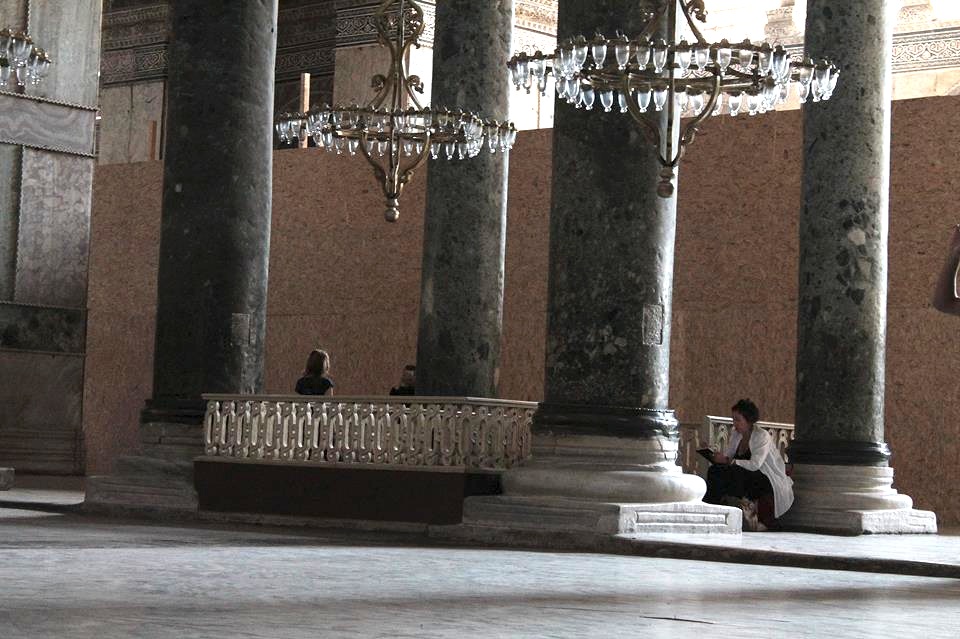
IT’S ALL ALIVE The date of this angel is probably slightly after 1261. That’s when the re-enfranchised Eastern Christians of Constantinople dug up Henri Dandolo and threw him out the window of Hagia Sophia, officially ending the 57-year Roman Catholic aftermath of the Fourth Crusade. You remember Dandolo, don’t you, from two posts back? The old blind Doge of Venice who told the Fourth Crusade to sack Constantinople? And he was buried in Hagia Sophia, center of Eastern Christianity and its foremost temple, which he turned into a cathedral after trashing its entire congregation and their city? That guy. Out the window, his bones gnawed by the dogs. How I love the history here.
This Angel is actually a Seraph, a sexless bodiless representation of Divine Thought. Its re-emergence in 2009, thanks to the Turkish government, colors the whole eastern side of the basilica. It’s the only whole survivor of four, mosaiced into the four pendentives below the dome. A pendentive is that triangular space that allows a dome to join with the square space beneath it. Why not fill the space with angels? Made sense to the Byzantines. Makes sense to me, but then I’ve been living here awhile.
ALL HISTORY MUST INCLUDE A CAT So: fifteen hours drawing this angel from this exact spot: a complete sweep of history. We have the 6th-Century windows around the dome, the post-Latin mosaic Angel, some of Sultan Abdulmecid’s 1841 paint, the Byzantine balustrade, an Ottoman chandelier, and a medallion with Abdulmecid’s tribute in Arabic to family and Allah. All of this in one shot required sitting on a campstool precisely lined up against certain scars on the marble floor, because I have to get up now and then, moving the stool, and the perspective hangs on a hair. Lots of concentration here! As always I muse, while drawing, on the passionate concentration of the original mosaic artists, keeping the grand gesture in such a slow tedious medium. That face up there is over three feet wide.
To break things up a little, I wandered around drawing those graffiti crosses, probably put here by Fourth Crusaders. We talked a lot about them in HOT CROSSES: Drawing Crusader Graffiti in Hagia Sophia. I was down on the floor in front of the nave drawing this one hacked into the floor when another sort of angel came over to watch, followed by his parents.
COMING OF AGE If there is an icon of boyhood in Turkey, this is it. Emirhan here is attired for his Sunnet, his circumcision, followed by a party to celebrate his manhood. Every Turkish boy goes through this ceremony, and it bonds them for life. It may or may not take place with an anesthetic, but it will take place. Before the great event the little boy parades around town in as grand a fashion as his parents can afford, often in this costume of a miniature Sultan. Normally I don’t take requests, but when his father asked I just couldn’t resist.
Here is one of Hagia Sophia’s stellar guards with Obama Gli Kedi, who our President petted on National TV while visiting Hagia Sophia back in 2008.
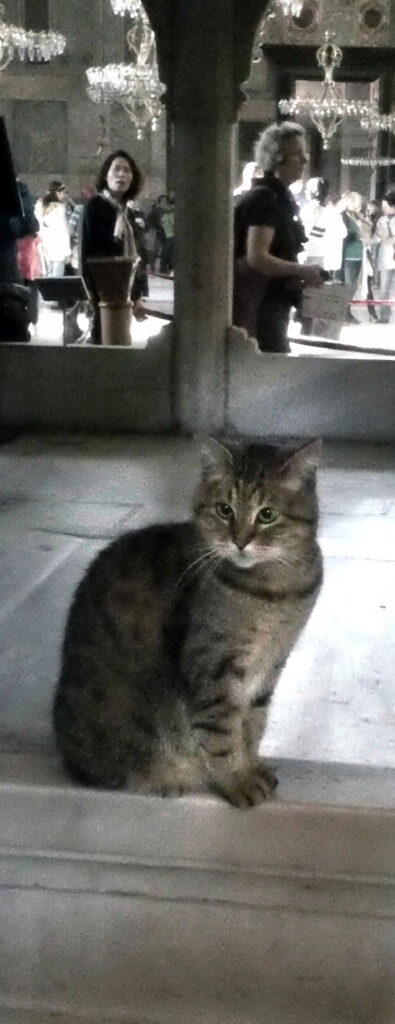
Hagia Sophia is popular with American Presidents: here it is in 1999 with the Clintons inside.
WHIRLIGIGS UNDER HEAVEN
And check out that inlay work above the pillars around the upper alcoves! I always loved whirligigs and so did the Emperor Justinian. St Catherine was one of his patron saints, and we find Catherine Wheels everywhere in Hagia Sophia. Is it mother-of-pearl? With some dark wood or tortoise-shell or black stone, porphyry in the circles…
Justinian and his Empress, Theodora, began building on Hagia Sophia in 532, to replace the previous temple which had been burned in the Nika Rebellion. To create what they hoped would be a glory for heaven, they commissioned Isador of Miletus, a physicist, and Anthemius of Tralles, an architect and mathematician. Justinian and Theodora’s love was legendary. Like Hagia Sophia, it has outshone all the contemporary criticism, all their probable and all too human flaws. For fifteen hundred years, now, it has stood, a miracle of sensual symmetry, of space and light and beauty. It’s what happens when great physics, architecture and mathematics combine with total faith and great love.
So, whatever this whirligig façade is made of, it was made in the 6th Century. It’s recently been cleaned, and what a revelation. It used to look like shallow gray bas-relief. Here’s a drawing from 2004, see? I couldn’t make out the design and had to make do with curlicues.
The roughened surface of this marble is fifteen centuries of people carving their names. Over time the names fade down into the marble, leaving a scratched, pitted texture I love.
PEELING TROMPE L’OEIL The far right arch in these photos is trompe l’oeil from the Fossati Brothers, Swiss architects hired in 1841 by Abdulmecid to do a restoration. That’s their yellow paint job peeling off the upper walls, trying to match the original gold mosaic below. The Fossati Brothers found the Angel face plastered over. They carefully documented it, drew it, and according to Islam’s proscription on faces, covered it up with a medallion like the ones still on the other three. Our angel is on the northeastern pendentive. The ones to the west are trompe l’oeil to match the mosaic ones to the east. The southeastern medallion may have a face under it. I sure wish I knew.
Here are more faces from Hagia Sophia’s wonderful security staff. I drew each one at different times and separated them for gift prints. If you are going to spend any time drawing monuments, be nice to the guards.
RELENTLESS BEAUTY
That there are faces at all on the walls of Hagia Sophia is due largely to Empress Irene of Athens, who ruled Byzantium at the turn of the eighth century to the ninth. Notice her shield and cross: she was a kind of warrior.
ICONS: PORTALS TO POWER Irene’s Emperor Leo from Armenia, the first Iconoclast, is said to have been influenced by Islam in his abhorrence of icons. We all know icons as those little gizmos that pop up on your desktop, letting you know where to click to access all manner of things.
Their origin, like so much else, is pretty much Byzantine. What the Byzantines were accessing was faith. Here are some religious icons.
A modern program icon designer works with much the same limitations as the original religious painters. In a small space with limited colors you must create an instantly recognizable image that conveys a sense of where you want the viewer to go. We icon designers want you to know you’ll be transported to Desktop or Skype or Adobe Photoshop. The Byzantines wanted you to be transported into Faith. Faith that the saint represented by the icon would intervene with the Power of the Universe to help you. Come to think of it, they’re not so different.
Icons are a touchy subject. In Communist Russia you could get into a lot of trouble for possessing them. Many were said to perform miracles, survive all manner of cataclysm. In our time icon has come to mean a powerful representational figure, or face, like Hitler meaning Fascism, or Steve Jobs representing idealistic progress. The Byzantines prayed to pictures of the saints, lit candles to them, went on their knees before them, fought wars under and for them. The power was in the faith, but Emperor Leo believed that people worshipped the pictures themselves, so he destroyed them. All of them. Every icon, large and small, and then every pictorial mosaic, fresco and bas-relief went. Hagia Sophia is full of empty frames, carved marble around a vacant space, and lone, austere crosses. The original gold mosaic ceiling, with its geometric designs, was allowed to remain. After the Iconoclasts– the breakers of images– had done with the pictures, they started in on the artists. Leo is not my favorite emperor, but at least there aren’t a lot of pictures of him.
HELL HATH NO FURY… Irene his wife was an Iconodule or Iconophile: she loved icons. She is remembered as a beauty: a tall noble brunette. One fable has Leo discovering some icons she’d hidden, and refusing to sleep with her afterwards.
Was she a woman scorned? Leo died in 775, and Irene set about gaining the throne. Beset by her own ministers, Bulgars, and Harun Al-Rashid, she never gave up…wait a minute. Worlds collide….Harun Al-Rashid? Isn’t he supposed to belong in Arabian Nights? Yes, and he did his best to invade Byzantium. Irene kept him out by paying him a whopping annual tribute. When the Pope refused to recognize her rule and crowned Charlemagne Roman Emperor, rather than sulking over the insult, she simply arranged to marry Charlemagne. But she was deposed first.
ECLIPSE OF THE SON Her son by Leo, Constantine VI, grew up in the shadow of his vivid autocratic mother. He too was an Iconoclast. When the inevitable clash came, Irene gave him short shrift: she seized the throne, and very likely in the same purple chamber in which she had borne him, she had him blinded. This killed him and sickened the people, who proclaimed it “a horror of Heaven” and blamed on it a 17-day solar eclipse.
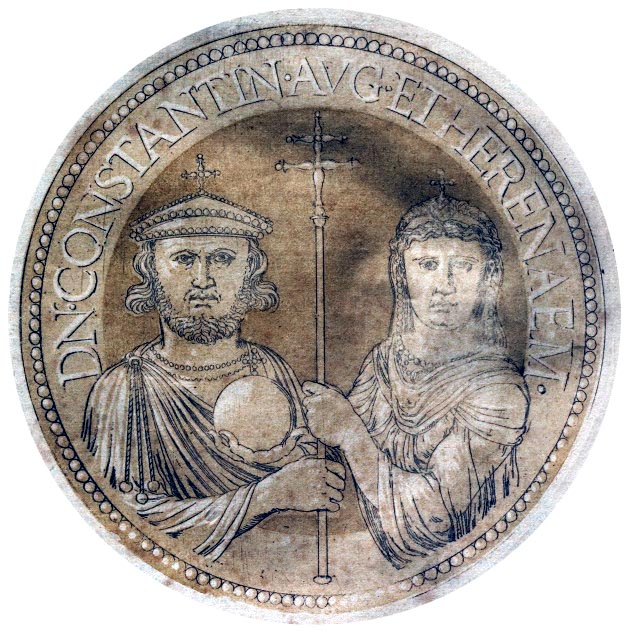
THE SKULL CARAFE Nevertheless Irene ruled for five years before being replaced by her minister Nicophorus. You remember Nicophorus? He wound up beheaded by Krum the Horrible, Khan of the Bulgars. That’s Nicophorus on the right, being carried in filled with beer.
THE SAINT The Iconoclasts stuck around until the mid-9th Century and finally petered out. Irene ended life on an island, spinning to support herself, and in Hagia Sophia, the heart of the kingdom she ravaged her soul to protect, there is no image of her. I doubt there’s one in Istanbul. Fourth Crusaders carried them all off to Venice, the city of that Doge thrown out the window. Yet she endures, for she restored image worship in Christianity. Under her rule in 787, the Seventh Ecumenical Council at Nicea refuted the Iconoclasts, declaring that artistic materials merely represent the saints, a belief upheld to this day. The glorious pictorial mosaics of St Savior in Chora, as well as many surviving in Hagia Sophia, are all from after Irene. Throughout Christianity, religious art endures, and it always has a face.
THE EVOLUTION OF AN ICON Santa Claus, called Noel Baba (Father Christmas) is big here in Turkey. St Nicholas himself was Bishop of Myra, down on Turkey’s Mediterranean Coast. A benevolent leader, he gave all his money to the poor, hiding dowries in the shoes of impoverished virgins to save their pride, which comes to us as the tradition of Christmas stockings. St Nicholas is huge all over Europe. Think of all those Greeks named Nick. Here’s one of many Russian icons of him.
At some point, he became mixed with Lapland myths of tall, fur-suited Father Christmas who lived with reindeer in the snow. Vikings were in Istanbul, the Varangian traders invited in the 9th Century. Here’s their graffiti in Hagia Sophia, and even I feel I’m stretching to imagine that’s when the mix began. But worlds DO collide here…could it be?
Victorian Clement Clark Moore turned Father Christmas / St Nicholas into a “a right jolly old elf” in his iconographic (!) poem The Night Before Christmas. And in 1930, Coca-Cola hired Norwegian-American illustrator Haddon Sundblom to depict St Nick for their ads in the Saturday Evening Post. This became the prototype for Santa Claus as we know him today.
Justinian undoubtedly included icons of St Nicholas in Hagia Sophia. After all, he built the church at Myra in memory of the 3rd-Century saint. And as the snow whirls in the darkness outside and the wind howls up over the mouth of the Bosporus on this 20th of December 2012, the day before believers in the Mayan Calendar tell us the world is going to end, it’s fitting that we end this post with a commemoration. Since the beginning of recorded history, people have been crying that the world is surely ending, but we will more surely see another Christmas, another New Year…
POSTSCRIPT: It’s years into After the Mayan Calendar. We may be flying blind, but we’re still flying. Once again, Happy Christmas to all, and to all a good night!
—-
All drawings Plein Air, 20″ X 7″ / 18cm X 52cm, drafting pens on rag paper, sketchbook format. All art ©Trici Venola. All drawings from The Drawing On Istanbul Project by Trici Venola, see description on this blog. Thanks for reading. We love your comments!
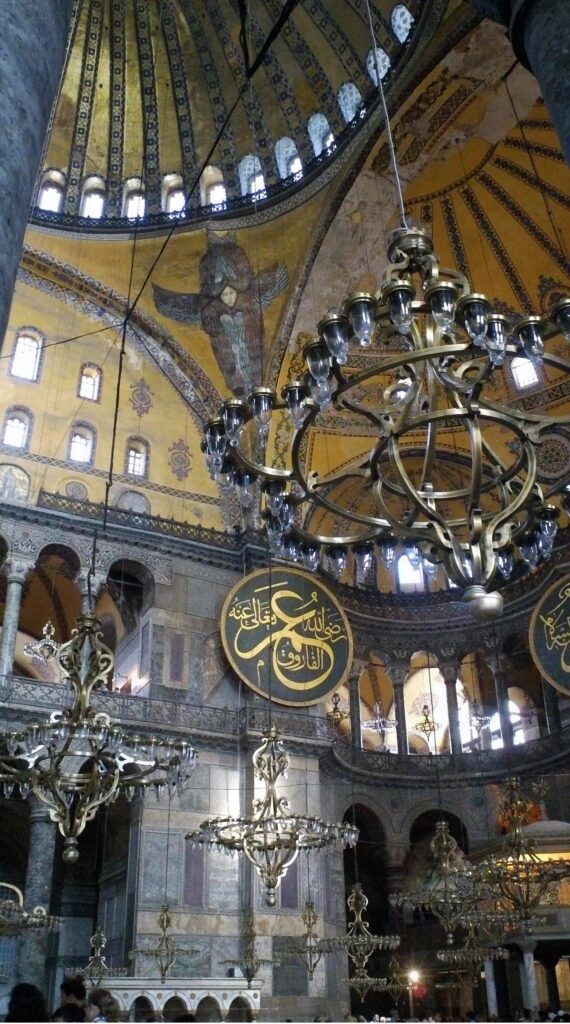
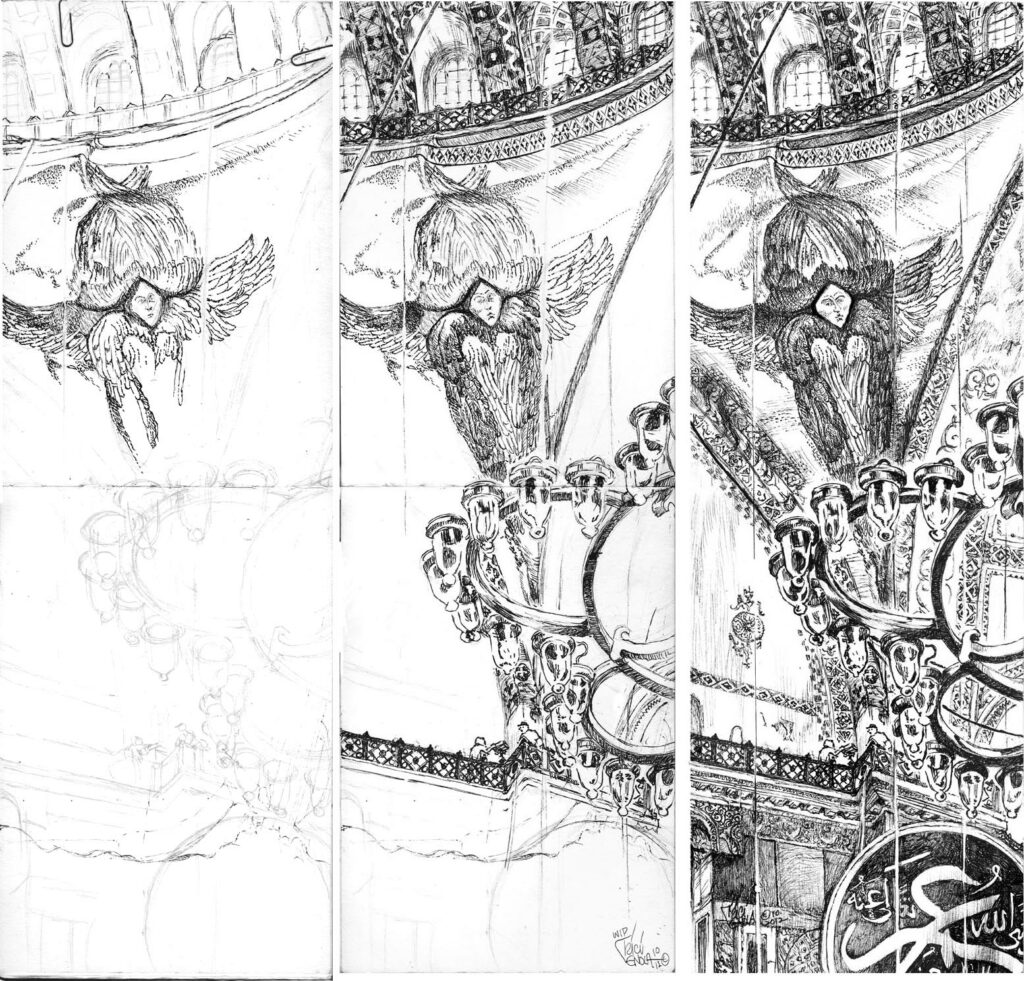
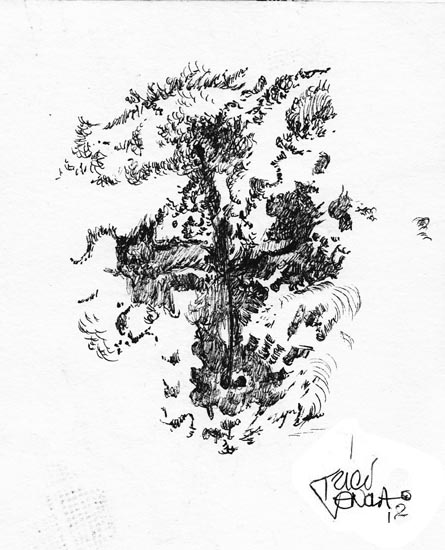
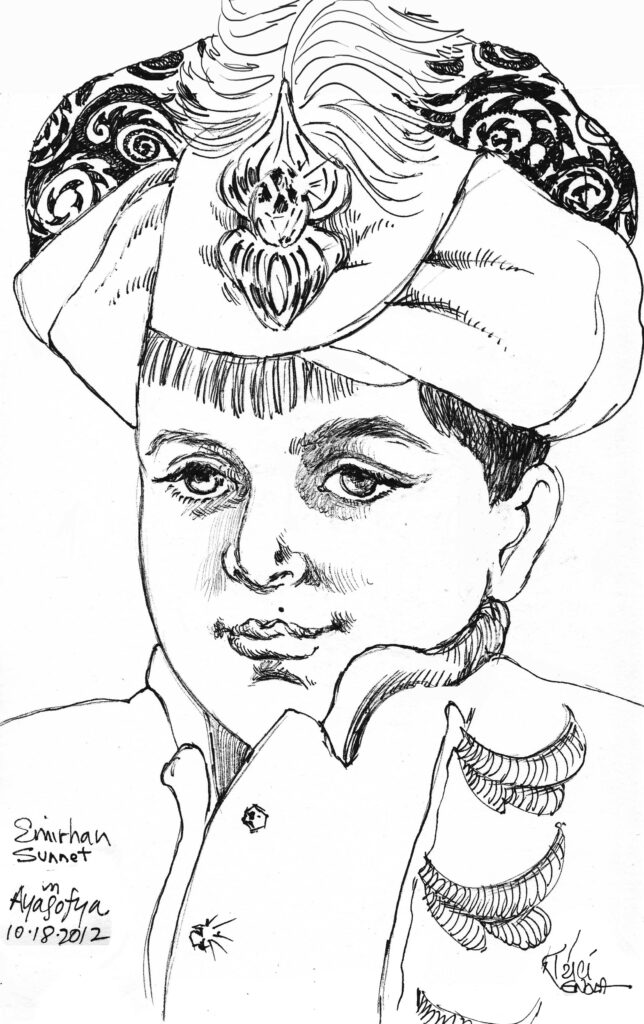
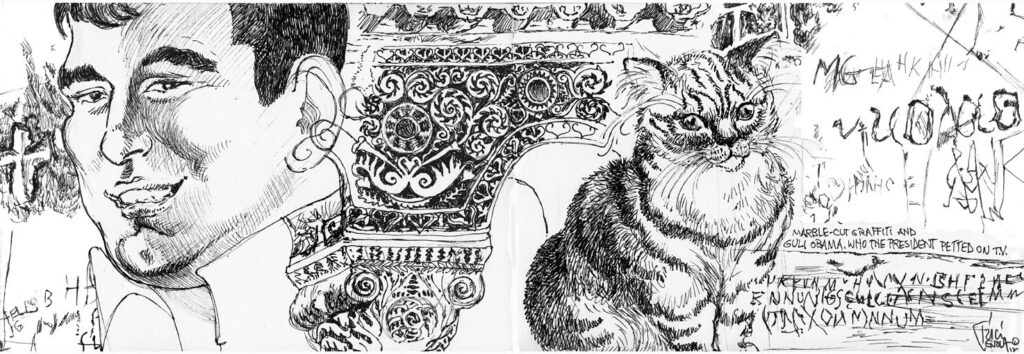
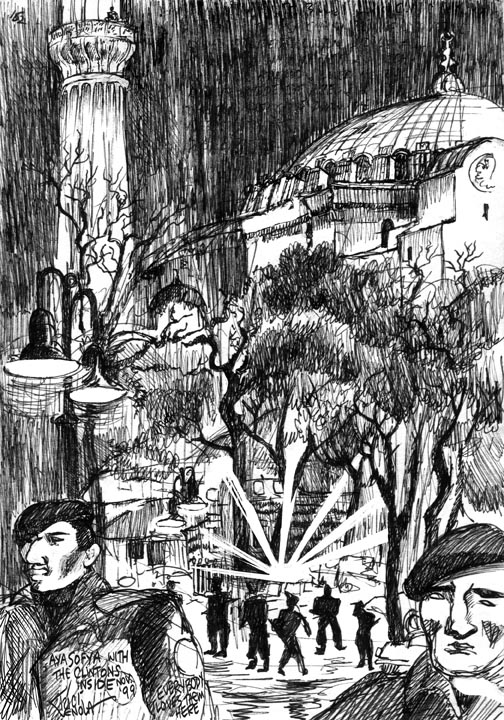
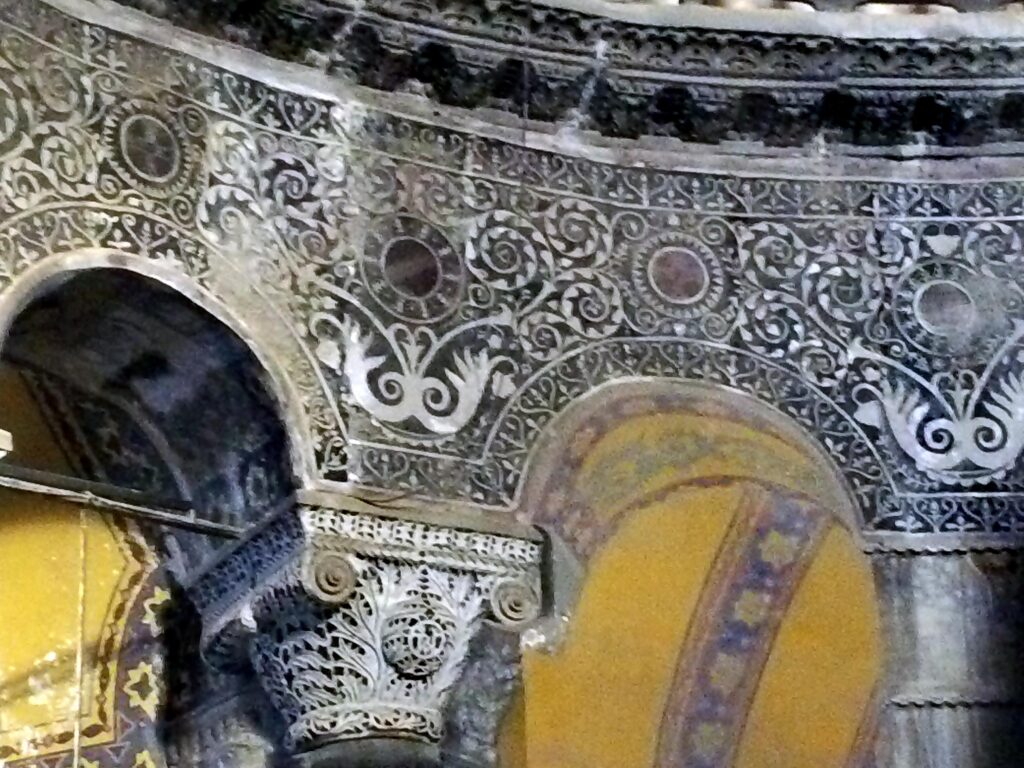
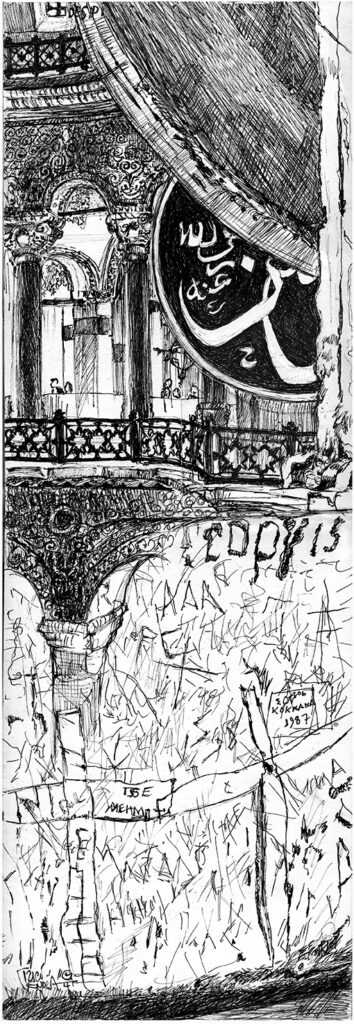
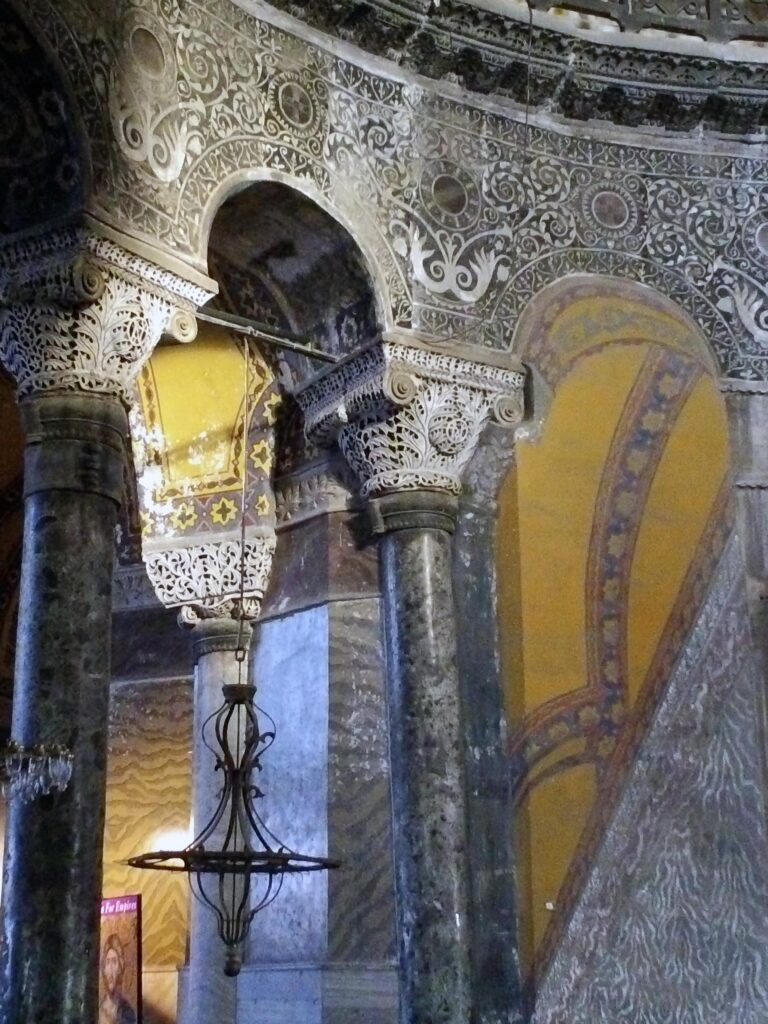
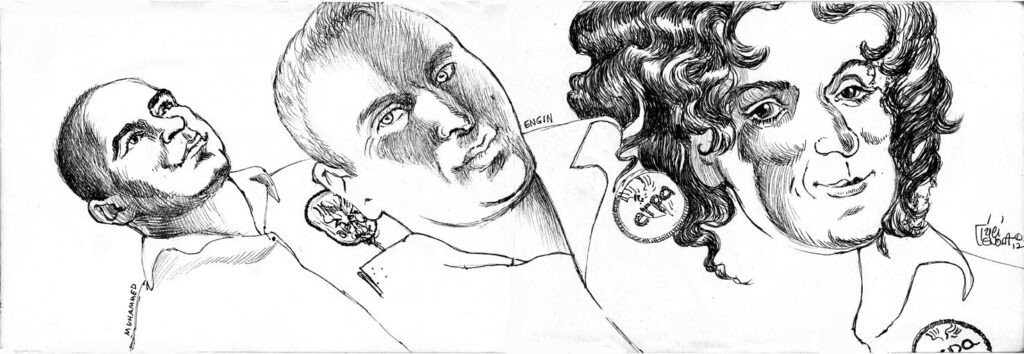
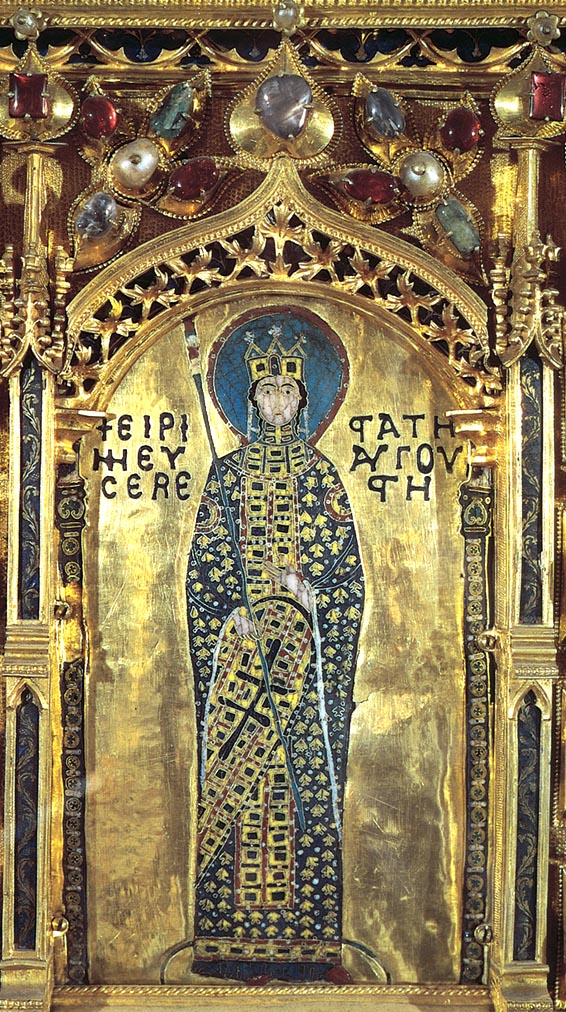

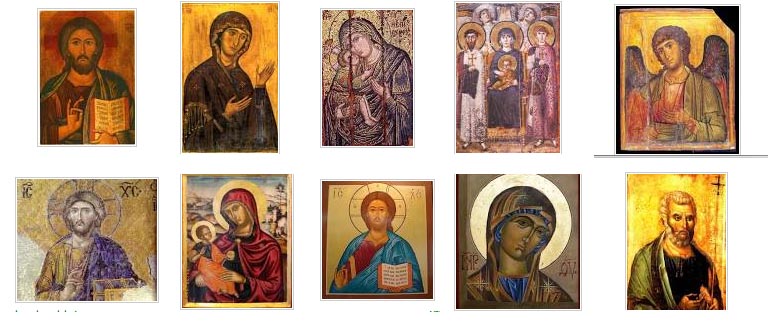
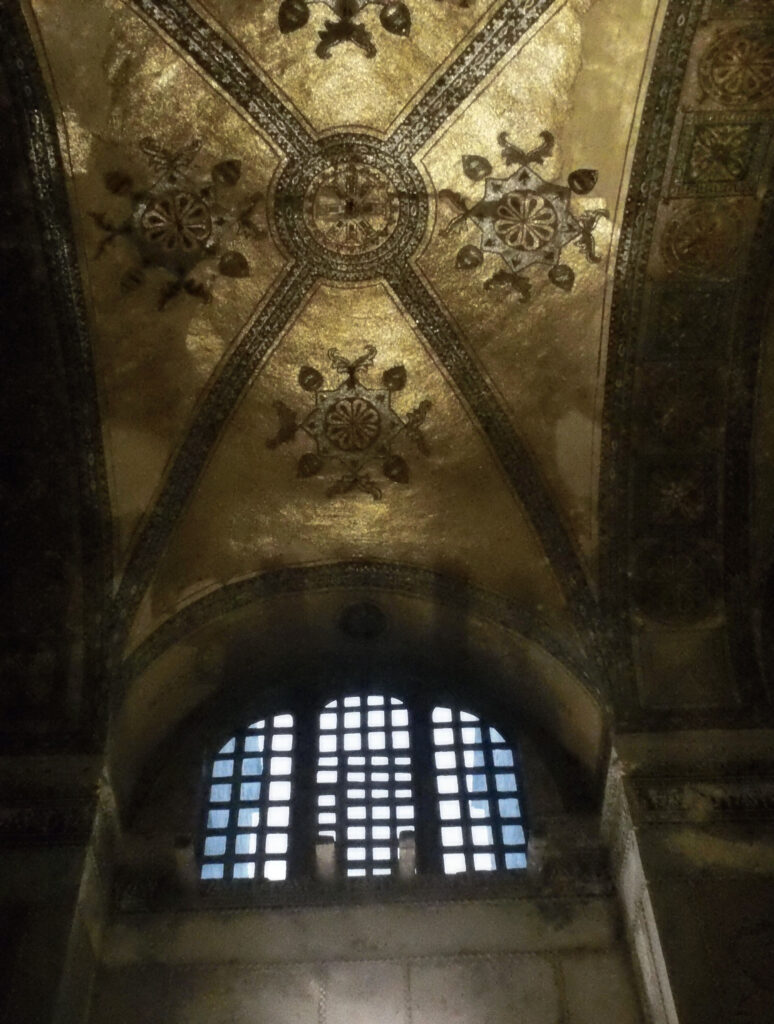
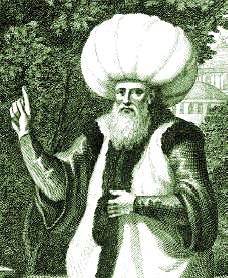
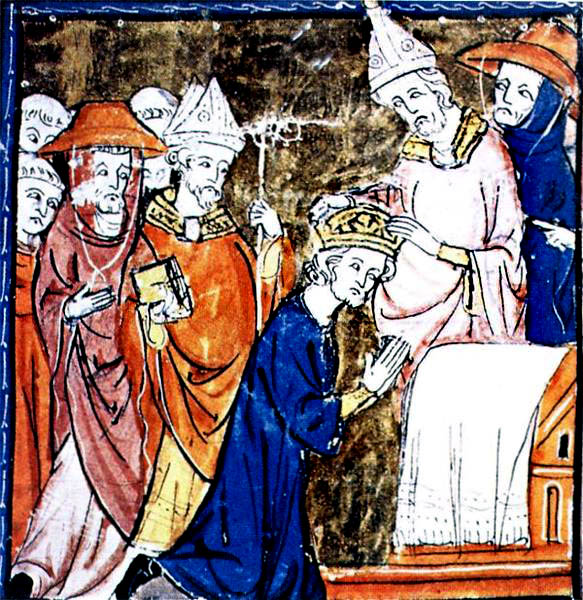
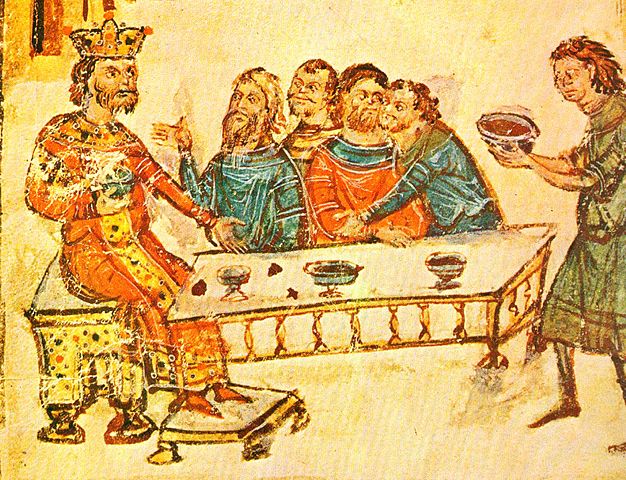
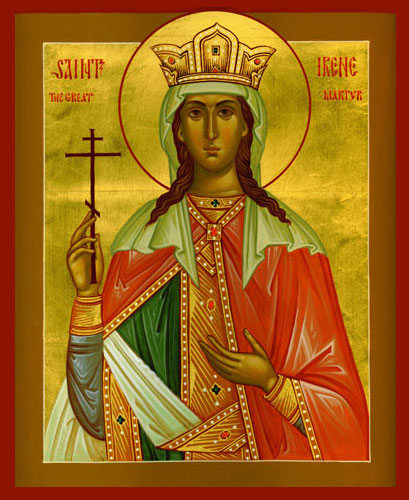
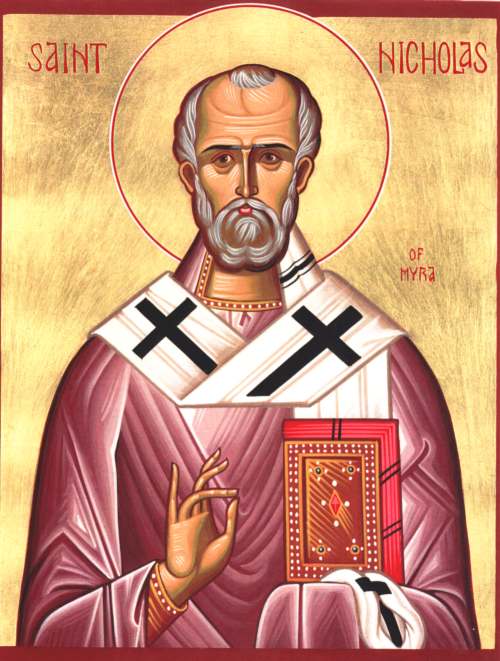
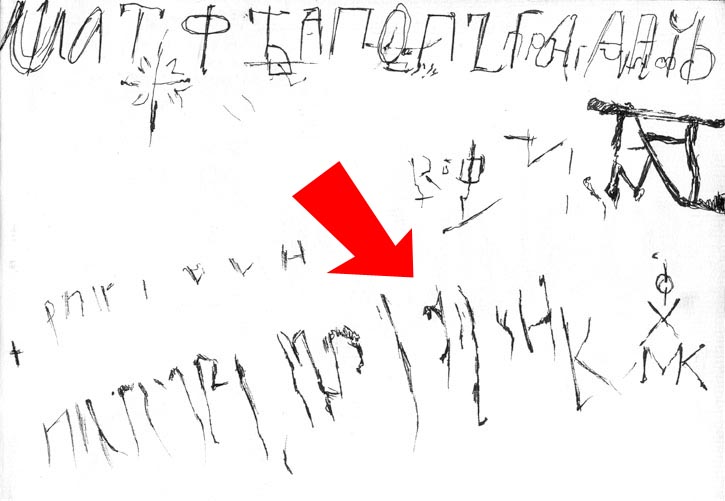
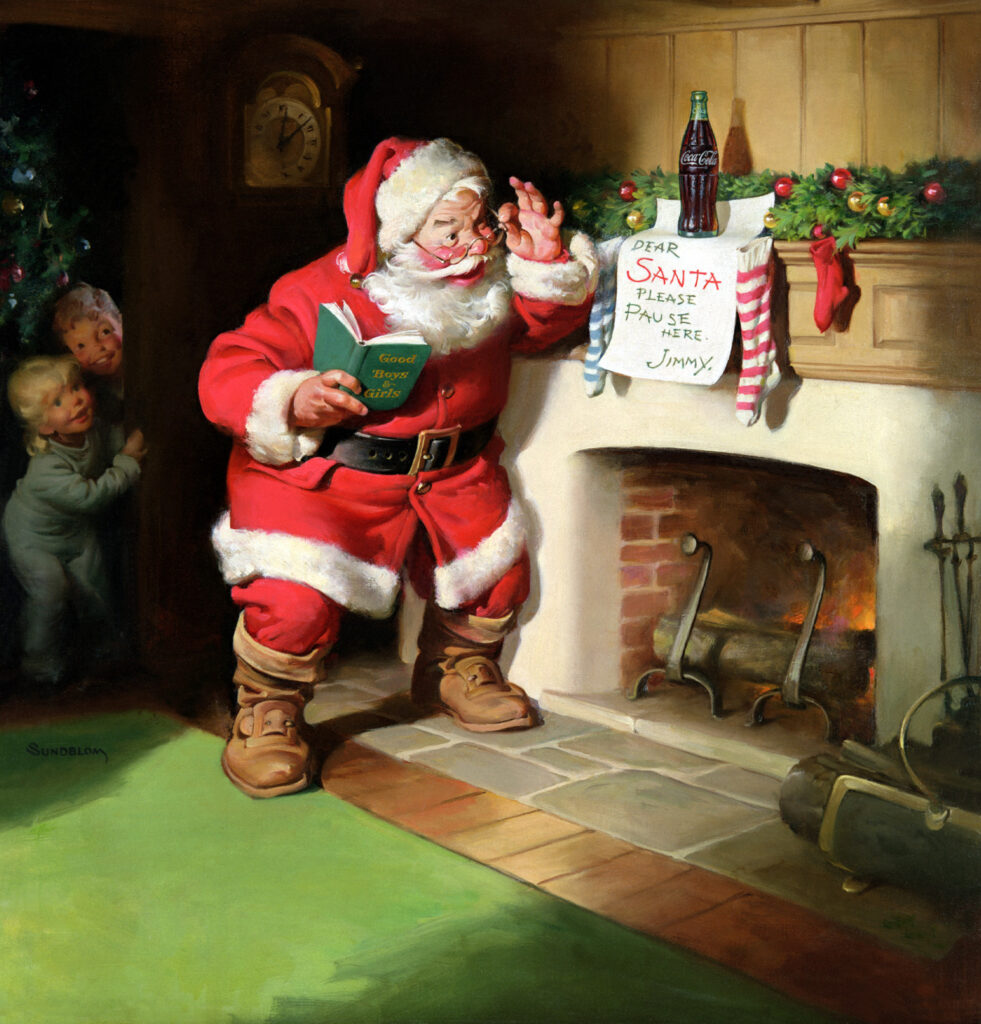
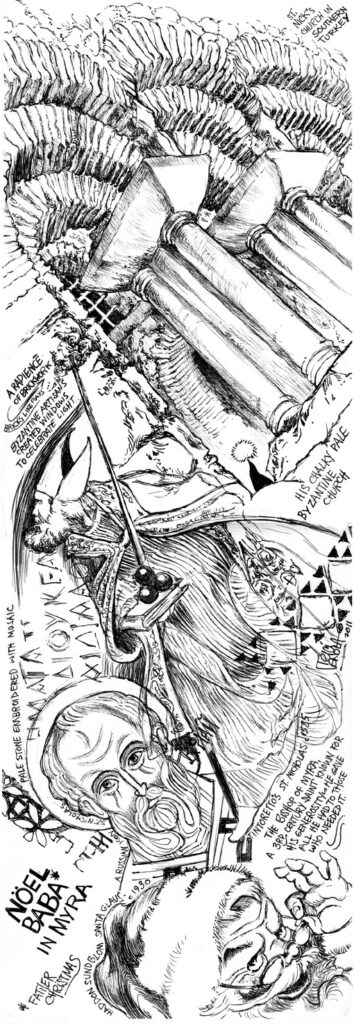
Awesome! The bodiless/sexless angel, the Obama Kitty, the icons and saint Nick, all in one read! Great photos, drawings, history lessons and inspiration for the holidays! You rock Trici!
“Halvdan was here”: there are I think 2 other runic inscriptions carved (probably by a belt knife) on that same balustrade and not all that far away from the Halvdan one; they have been documented for years. The first one discovered, as it were, was the Halvdan one. I will have to look them up; I think the info appeared in an issue of “Nytt om Runer” (News about Runes). Talk about your classic graffiti, not much has changed from then to now.
WOW, Trici……………………..
I continue to be inspired by your art, and your blog is such a fun read. Thank you.
And timeless. Your work is also wonderfully timeless. And full of times. Genius of your many genres, Woman! xox